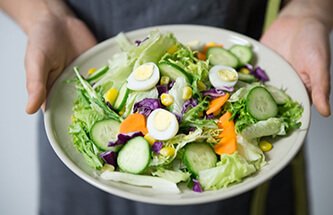Lifestyle Tips to Prevent Osteoporosis

Osteoporosis is a bone condition that causes bones to become weak and porous in nature. The condition often affects the entire skeleton, so patients experience frequent fractures, often first in hips, ankles, and wrists. Although osteoporosis is commonly treated with doctor prescribed medication (i.e., Evenity (or Romosozumab). There are risk factors that lead to the development of this condition, such as family history, female gender, cigarette smoking, lack of exercise, low calcium diet, and menopause.
However, there are also several lifestyle changes that can help prevent osteoporosis:
1. Do yoga
Studies have shown yoga to be an excellent way to prevent osteoporosis. Yoga enables you to balance and coordinate your body muscles, which strengthen your bone to prevent osteoporotic fracture. However, some yoga movements might increase the risk of fractures. Yoga was found to increase bone density when done consistently and properly. It improves your balance and flexibility that helps prevent you from falling and getting fractures. Yoga practices that help to prevent osteoporosis include those that strengthen your back, such as baby cobra, bridge, and sphinx.
2. Consume a diet rich in calcium
Calcium element is essential for the optimal health of your bone throughout your life. And the best way to supplement calcium is through diet, but if that fails, you can use a calcium supplement. As osteoporosis is associated with weak bones, calcium consumption helps to build and maintain your strong bones. Besides, for your muscles, nerves, or heart to function correctly, they require calcium. If you want to prevent osteoporosis by consuming a diet rich in calcium, consume: daily products (such as yogurt, cheese, and milk), dark green, leafy vegetables(such as kale, broccoli, and collards), cereals, bread, pasta, salmon or sardines among other food.
3. Get regular bone density screenings
Osteoporosis is a bone disease. The best way to prevent osteoporosis is to have a bone density test to help diagnose the disorder before you start to break bones. It is a test that will estimate your bone density and whether there are chances of them breaking. You have to undertake the test if you are a woman above 65 years and a man above 70 years, a woman at menopause age having risk factors, you are breaking bones at 50 years, or you are a woman under 65 years at postmenopausal age.
4. Quit smoking
Cigarette smoking has been associated as a risk factor causing osteoporosis decades ago. Some studies have shown there is a direct relationship between tobacco and a decrease in bone density. Cigarette smoke contains a vast amount of various articles that will attack and overwhelm your body’s natural defenses. It results in damages in your body, including organs, cells, and hormones that keep your bones healthy. Hormones such as estrogen help to keep your bone strength, and tobacco toxins will upset their balances. As the liver continues to produce more estrogen-destroying enzymes, you experience bone loss. The best option to protect your bones is when you quit smoking. It will help in limiting smoking-related bone losses.
5. Supplement with vitamin D
Vitamin D is essential for your life and, mostly, the prevention of osteoporosis. Vitamin D helps in building strong and dense bones when young and improves your health as you age. If you want to supplement yourself with vitamin D for strong bones and density, consume seafood and fatty fish, mushrooms, egg works, and spend time in sunlight.
6. Do resistance training
As your body ages, your bones weaken. It will impact your ability to walk, stand, or perform other physical activities. That will put you into risk for fractures, especially if you have osteoporosis. Regular exercise is one of the best ways to prevent osteoporosis as it helps to strengthen your bones. Even if you have osteoporosis, exercising is a perfect way to maintain your bone mass. The best exercises to help prevent the development of osteoporosis include strength training (such as squats, push-ups, lifting weights); and regular weight-bearing exercises ( such as dancing, walking, and jogging). Exercises not only help to build muscles and endurance, but they also help to thicken and maintain the amount of your bone.



